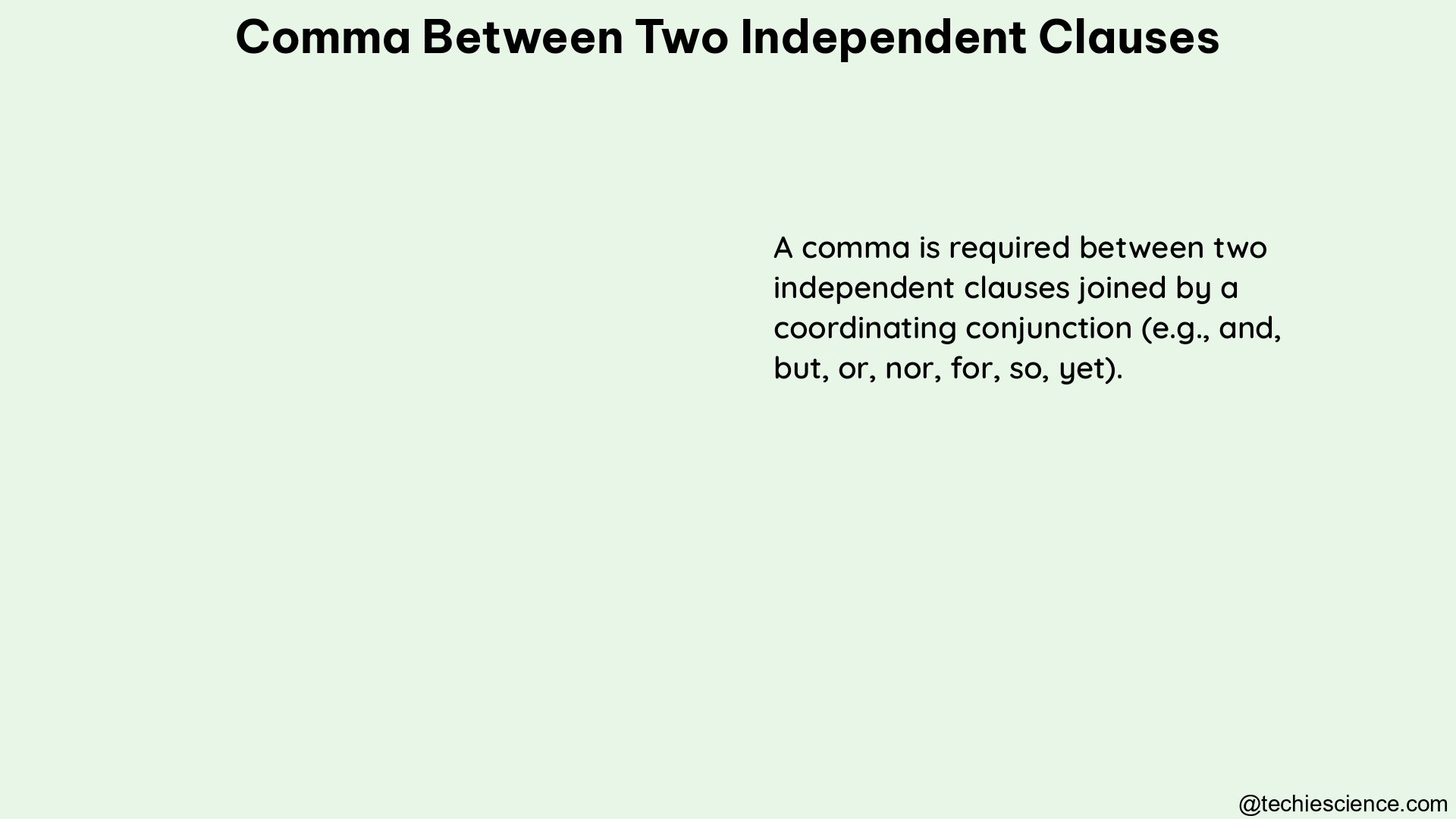When dealing with commas between two independent clauses, there are specific rules and considerations to keep in mind. This comprehensive guide will provide you with a deep understanding of the nuances and best practices for using commas effectively in your writing.
Rule 1: Use a Comma Before a Coordinating Conjunction
Independent clauses are clauses that can stand alone as separate sentences. Coordinating conjunctions, such as and, but, for, or, nor, so, and yet, are used to connect these independent clauses.
Examples:
– The protest was successful, but steps toward a solution must still be taken.
– The student explained her question, yet the instructor still didn’t seem to understand.
– Yesterday was her brother’s birthday, so she took him out to dinner.
It’s important to note that the comma is necessary to separate the two independent clauses and maintain clarity in the sentence structure.
Rule 2: Consider the Length and Flow of the Clauses

When dealing with short independent clauses, omitting the comma between them can be acceptable for better flow and readability.
Examples:
– She waved her wand and the rabbit disappeared.
– She waved her wand, and the rabbit disappeared. (Both are correct, but the first is more concise.)
The decision to include or omit the comma in such cases depends on the specific context and the writer’s preference for maintaining a smooth, natural flow in the sentence.
Rule 3: Avoid Comma Splices
A comma splice occurs when two independent clauses are joined solely by a comma, without the use of a coordinating conjunction or other appropriate punctuation.
Comma Splice Example:
– The deadline is tomorrow, I need to finish the project.
Fixes:
1. Add a coordinating conjunction:
– The deadline is tomorrow, and I need to finish the project.
2. Change the comma to a semicolon:
– The deadline is tomorrow; I need to finish the project.
3. Write the clauses as separate sentences:
– The deadline is tomorrow. I need to finish the project.
Avoiding comma splices is crucial for maintaining proper sentence structure and avoiding common grammatical errors.
Rule 4: Use Commas for Clarity and Nonessential Elements
Introductory Clauses, Phrases, or Words
Use commas after introductory clauses, phrases, or words to separate them from the main clause.
Examples:
– Because of unfair wages, the union was prepared to strike.
– If inequalities continue, the guillotine needs to make a comeback.
Nonessential Clauses, Phrases, or Words
Use commas to set off nonessential clauses, phrases, or words that provide additional information but are not necessary for the core meaning of the sentence.
Examples:
– That Tuesday, which happens to be my birthday, is the only day I am available to meet.
– The food, on the other hand, is rather bland.
Proper use of commas in these cases can enhance the clarity and readability of your writing.
Rule 5: Consider Style and Context
Formality
In formal writing, it is generally recommended to use commas between independent clauses to maintain a more structured and precise style.
Informal Writing
In informal writing, such as casual conversations or personal communications, omitting commas between independent clauses can be more common, as it can contribute to a more natural and conversational flow.
The decision to include or omit commas in such cases should be guided by the specific context and the desired tone and style of the writing.
Advanced Considerations
Compound Subjects and Predicates
When dealing with compound subjects or predicates, the use of commas can vary depending on the specific structure and clarity of the sentence.
Example with Compound Subject:
– John, and his wife Mary, went to the park.
– John and his wife Mary went to the park.
Example with Compound Predicate:
– She sang, and danced, at the party.
– She sang and danced at the party.
In these cases, the decision to include or omit commas often depends on the length and complexity of the elements, as well as the desired emphasis and flow of the sentence.
Correlative Conjunctions
Correlative conjunctions, such as both…and, either…or, neither…nor, also require careful consideration when using commas.
Example:
– Both the teacher, and the students, were excited about the field trip.
– Both the teacher and the students were excited about the field trip.
The comma placement in these cases can affect the meaning and emphasis of the sentence, so it’s important to understand the specific rules and guidelines for using commas with correlative conjunctions.
Conclusion
Mastering the use of commas between independent clauses is a crucial skill for effective and clear writing. By understanding the rules, considerations, and best practices outlined in this comprehensive guide, you can confidently navigate the nuances of comma usage and elevate the quality of your written communication.
Remember, the strategic placement of commas can significantly impact the meaning, flow, and readability of your sentences. Continuously practice and refine your comma usage, and you’ll be well on your way to becoming a comma expert.
References:
- Commas, Semicolons, and Colons
- Is a Comma Required Between Two Independent Clauses?
- Extended Rules for Commas
- Do You Put a Comma Between 2 Independent Clauses?
- The Comma: A Comprehensive Guide

Hi…. I am Goutam Datta. I have completed a double M. A. in English and B. Ed. I am a creative writer. Currently, I am a part of the LambdaGeeks.